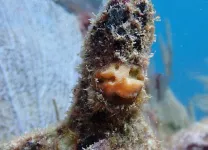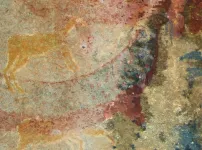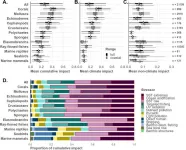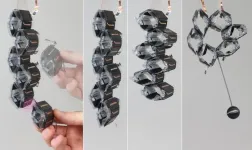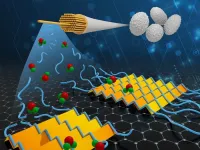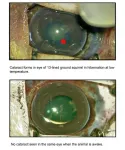(Press-News.org) WASHINGTON, D.C.—A new website, AnimalMethodsBias.org, created by the Coalition to Illuminate and Address Animal Methods Bias (COLAAB), provides researchers guidance and resources aimed at helping them successfully publish nonanimal biomedical research by overcoming the preference some peer reviewers have for animal-based research methods.
“We recently found that half of researchers surveyed had been asked by reviewers to add an animal experiment to their otherwise animal-free study,” says Catharine E. Krebs, PhD, who leads the COLAAB and is a medical research program manager with the Physicians Committee for Responsible Medicine. “The publish-or-perish academic paradigm can pressure researchers to concede these requests—even when they don’t think they’re justified.”
Animal methods bias can cause delays in publication or force authors to resubmit to other journals, often lower-impact ones.
Nonanimal methods, including complex in vitro models derived from human cells, like tissue chips and organoids, are becoming increasingly popular among biomedical researchers to model human biology and clinical characteristics.
“Addressing animal methods bias and other barriers to the broader use of nonanimal approaches will require systemic changes across the biomedical enterprise, but there are actions researchers can take in the meantime to boost their chances of publishing animal-free studies,” adds Krebs.
AnimalMethodsBias.org is now available for nonanimal researchers to use when designing studies, preparing and submitting manuscripts, and responding to reviews. It houses the COLAAB’s Author Guide for Addressing Animal Methods Bias in Publishing, which has several sections intended to help prevent and address instances of animal methods bias, like the requests for animal experiments described above. The Author Guide includes detailed sections on:
Experimental Resources. A database of animal-free experimental platforms and tools.
Preregistration. Information on specifying and registering a research plan before conducting the study.
Manuscript Preparation. Best practices for framing and reporting findings.
Journal Database. Journals with a track record of publishing nonanimal studies for consideration upon submission.
Suggesting Reviewers. Recommendations for finding and suggesting suitable reviewers during manuscript submission.
Responding to Biased Reviews. Guidelines and template responses to help authors to identify biased reviews and address them confidently.
Reference Library. A comprehensive library of more than 800 papers and other references relevant to animal-free research.
Originally published in Advanced Science, the Author Guide is now living resource that will be kept up to date with the rapidly evolving field of nonanimal methods. The COLAAB encourages feedback on additions and amendments to its databases and reference library. The site also includes a list of COLAAB publications as well as information on upcoming and past COLAAB events at meetings including the European Society for Alternatives to Animal Testing Congress, the Latin American Congress on Alternative Methods to Animal Testing, and the American Society for Cellular and Computational Toxicology Annual Meeting.
The COLAAB was formed following an April 2022 workshop exploring animal methods bias in publishing. The COLAAB is an international collaboration of researchers and advocates led by the Physicians Committee for Responsible Medicine and including representatives from Humane Society International, the Berlin Institute of Health at Charité, the Center for Alternatives to Animal Testing at Johns Hopkins Bloomberg School of Public Health, Utrecht University, York St John University, Fund for the Replacement of Animals in Medical Experiments, and People for the Ethical Treatment of Animals, as well as independent scholars. In 2024, the COLAAB won the Lush Prize Recognition Award for Major Science Collaboration.
END
New website helps researchers overcome peer reviewers’ preference for animal experiments
2024-09-18
ELSE PRESS RELEASES FROM THIS DATE:
Can the MIND diet lower the risk of memory problems later in life?
2024-09-18
MINNEAPOLIS – People whose diet more closely resembles the MIND diet may have a lower risk of cognitive impairment, according to a study published in the September 18, 2024, online issue of Neurology®, the medical journal of the American Academy of Neurology. Results were similar for Black and white participants. These results do not prove that the MIND diet prevents cognitive impairment, they only show an association.
The MIND diet is a combination of the Mediterranean and DASH diets. It includes green leafy vegetables like spinach, ...
Some diabetes drugs tied to lower risk of dementia, Parkinson’s disease
2024-09-18
MINNEAPOLIS – A class of drugs for diabetes may be associated with a lower risk of dementia and Parkinson’s disease, according to a study published in the September 18, 2024, online issue of Neurology®, the medical journal of the American Academy of Neurology.
The study looked at sodium-glucose cotransporter-2 (SGLT2) inhibitors, which are also known as gliflozins. They lower blood sugar by causing the kidneys to remove sugar from the body through urine.
“We know that these neurodegenerative diseases like dementia and Parkinson’s disease are common and the number of cases is growing as the ...
Propagated corals reveal increased resistance to bleaching across the Caribbean during the fatal heatwave of 2023
2024-09-18
SECORE International’s Coral Seeding approach utilizes assisted reproduction, the breeding of corals, for reef restoration. This approach is realized within a training and partner network throughout the Caribbean. Now, a peer-reviewed study shows that all the effort was worthwhile: during the devastating heatwave in the Caribbean in 2023, the young, bred corals out on the reef stayed healthy while most of the remaining wild corals bleached and many died in the aftermath.
The summer of 2023 was deadly for many corals in the Caribbean Basin. An unprecedented heatwave, in intensity as well as in duration, hit the Caribbean with catastrophic ...
South African rock art possibly inspired by long-extinct species
2024-09-18
A mysterious tusked animal depicted in South African rock art might portray an ancient species preserved as fossils in the same region, according to a study published September 18, 2024 in the open-access journal PLOS ONE by Julien Benoit of the University of the Witwatersrand, Johannesburg, South Africa.
The Horned Serpent panel is a section of rock wall featuring artwork of animals and other cultural elements associated with the San people of South Africa, originally painted between 1821 and 1835. Among the painted figures is ...
Even marine animals in untouched habitats are at risk from human impacts
2024-09-18
Climate change and a range of other human impacts are putting marine animals at risk of extinction – even those living in almost pristine marine habitats and diverse coastal regions – reports a new study by Casey O'Hara of the National Center for Ecological Analysis and Synthesis at the University of California, Santa Barbara, USA, and colleagues, published September 18, 2024 in the open-access journal PLOS ONE.
Human activities on land and sea, in combination with climate change, are degrading coastal ...
Hexagonal electrohydraulic modules shape-shift into versatile robots
2024-09-18
Stuttgart – Scientists at the Max-Planck-Institute for Intelligent Systems (MPI-IS) have developed hexagon-shaped robotic components, called modules, that can be snapped together LEGO-style into high-speed robots that can be rearranged for different capabilities. The team of researchers from the Robotic Materials Department at MPI-IS, led by Christoph Keplinger, integrated artificial muscles into hexagonal exoskeletons that are embedded with magnets, allowing for quick mechanical and electrical connections. The team’s work, “Hexagonal electrohydraulic modules for rapidly reconfigurable high-speed robots” will be published in Science ...
Flexible circuits made with silk and graphene on the horizon
2024-09-18
RICHLAND, Wash.—After thousands of years as a highly valuable commodity, silk continues to surprise. Now it may help usher in a whole new direction for microelectronics and computing.
While silk protein has been deployed in designer electronics, its use is currently limited in part because silk fibers are a messy tangle of spaghetti-like strands.
Now, a research team led by scientists at the Department of Energy’s Pacific Northwest National Laboratory has tamed the tangle. They report in the journal ...
Scott Emr and Wesley Sundquist awarded 2024 Horwitz Prize for discovering the ESCRT pathway
2024-09-18
NEW YORK, NY (September 18, 2024)—Columbia University will award the 2024 Louisa Gross Horwitz Prize to Scott Emr and Wesley Sundquist for discovering the ESCRT (Endosomal Sorting Complexes Required for Transport) pathway and revealing how it works.
ESCRT (pronounced “escort”) complexes deform the cell membrane and bend parts of it away from the cytoplasm, the space that houses all material inside a cell. This unique process plays an essential role in keeping cells healthy by packaging and sorting molecules, removing waste, and regulating important functions such as cell division, neuron remodeling, ...
Versatile knee exo for safer lifting
2024-09-18
Images
A set of knee exoskeletons, built with commercially available knee braces and drone motors at the University of Michigan, has been shown to help counteract fatigue in lifting and carrying tasks. They helped users maintain better lifting posture even when tired, a key factor in defending against on-the-job injuries, the researchers say.
"Rather than directly bracing the back and giving up on proper lifting form, we strengthen the legs to maintain it," said Robert Gregg, U-M professor of robotics and corresponding author of the study in Science Robotics. "This differs from what's more commonly done in industry."
Already ...
NIH-led studies point to potential development of a cataract drug
2024-09-18
Researchers at the National Institutes of Health (NIH) and their collaborators have identified a protein, known as RNF114, that reverses cataracts, a clouding of the eye’s lens that occurs commonly in people as they age. The study, which was conducted in the 13-lined ground squirrel and rats, may represent a possible surgery-free strategy for managing cataracts, a common cause of vision loss. The study published in the Journal of Clinical Investigation.
“Scientists have long searched for an alternative to cataract surgery, which is effective, but not without risk. Lack of access to cataract surgery is a barrier to care in some ...
